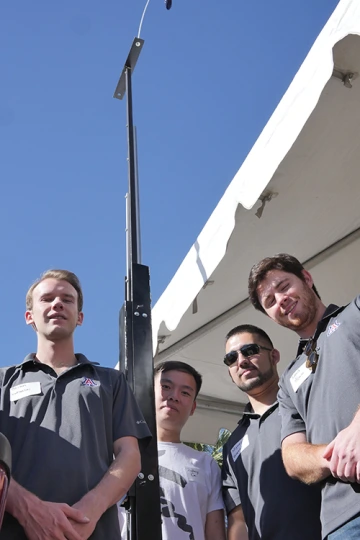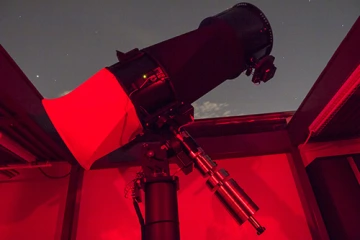Out of the Gate

Project Title: Multifrequency Antenna Mast System for Large Mining Trucks
Team 16036 Members:
Robert Bloom, mechanical engineering
Zichong Cai, mechanical engineering
Wyatt Peña, engineering management
Miguel Vasquez, engineering management with mechanical engineering minor (team lead)
Brian Wargasaki, mechanical engineering
Sponsor: Caterpillar

Project Title: Design, Fabrication and Integration of Space Object Characterization Sensors
Team 16065 Members:
Sameep Akhil Arora, mechanical engineering (team lead)
Ryan Bronson, optical sciences and mathematics
Marco Colpo, optical sciences and mathematics
Evelyn Hunten, electrical and computer engineering
Lindsey Jeffries, biomedical engineering and mathematics
Sponsor: UA Lunar and Planetary Laboratory
For UA Engineering students, the senior capstone project isn’t just a classroom exercise, it’s their first effort as engineering professionals. After Design Day ends, these projects often go right to work.

Antenna Mast Tough Enough for Mining Trucks
When they got together to create their Design Day project, Team 16036 built an antenna mast for one of the world’s toughest environments, the open pit mine.
Sponsored by Caterpillar, the five-member team was asked to create a light, durable and easy-to-service antenna mast for mine site haul trucks. These trucks operate around the clock and are only taken out of service for repairs and maintenance. Due to intense cost pressures in the mining industry, this downtime must be minimized.
Haul trucks can stand as tall as three stories and weigh 250 tons empty. They must stay in constant contact with mine operators and do so via complex electrical systems that enable two-way communications and telemetry through radios, satellite positioning systems, Wi-Fi and cellular data transfer.
Haul trucks need antennas with clear line of sight to both the sky and the offboard transmission stations that are mounted throughout some mines. Because the steel dump body acts as a signal blocker, antennas are mounted on long poles that extend out from and above the truck.
Real-Life Engineering Challenge
During Design Day, Team 16036 displayed their completed system, which included the mast, mounting brackets, antenna mountings and cable routings.
“The students took a new approach at solving a real-life engineering challenge,” said Joe Tabor, Caterpillar engineering project team leader and the students’ mentor. “The antenna mast was installed on a truck at Caterpillar’s Tucson Proving Ground for a proof-of-concept test. With some refinements, the antenna mast could be applied on large mining trucks in the future.”
Caterpillar engineering manager Adam Hales added, “The senior design projects are great for Caterpillar, the University of Arizona, and the students. Each group benefits in different ways. The most obvious are, for the students, learning how to manage a real-world project and, for Caterpillar, getting a product at the end of the project.
“Beyond the product is the interaction and exposure we get with the University and the students. We get to educate the students about Caterpillar and generate excitement in the engineering work we do. This gives us access to emerging engineering talent and future leaders who are looking to start their careers. Overall, it is an excellent opportunity for everyone.”
Building Satellite-Tracking Telescopes
As we become increasingly dependent on satellites, space is subsequently more congested, contested and competitive. Detection and characterization of moving objects in Earth orbit is vital for protecting critical space assets, but it’s a task for which traditional astronomical telescopes are ill-suited.
The five members of Team 16065 rose to this challenge. Although none of them had any prior telescope-building experience, they constructed two 24-inch telescopes that will be used for tracking satellites and space junk. Starizona, a local astronomy business, trained the students and tested the telescopes’ optics.
Team’s Telescopes Net $70,000 in Savings

Frugality was paramount, so the team’s designs included mirrors recycled from the defunct telescope in the old Kuiper observatory. The total $30,000 cost for both telescopes is less than a third of what the UA would have spent on similar off-the-shelf telescopes, two of which would total $100,000.
The team’s faculty adviser, Lunar and Planetary Laboratory assistant professor Vishnu Reddy, said that one of the telescopes is monitoring geostationary satellites from LPL’s sixth floor. It’s the first telescope to be installed on campus since the 1990s. Reddy is still seeking a permanent home for the second telescope.
An expert in space situational awareness, Reddy will be able to use the student-built telescopes to identify unique color signatures of satellites, to find out exactly which one is which.
“The UA is going to be a leader in space situational awareness, and we really want to capitalize on our exceptional undergraduate students,” Reddy said. “This is also workforce development. We need an American workforce that can rise to the challenges of our national security needs and the needs of our nation.”
Reddy plans to advise another Engineering Design team during the coming year. He’ll be challenging the students to build an instrument that will identify the spectral signatures of spacecraft parts.

